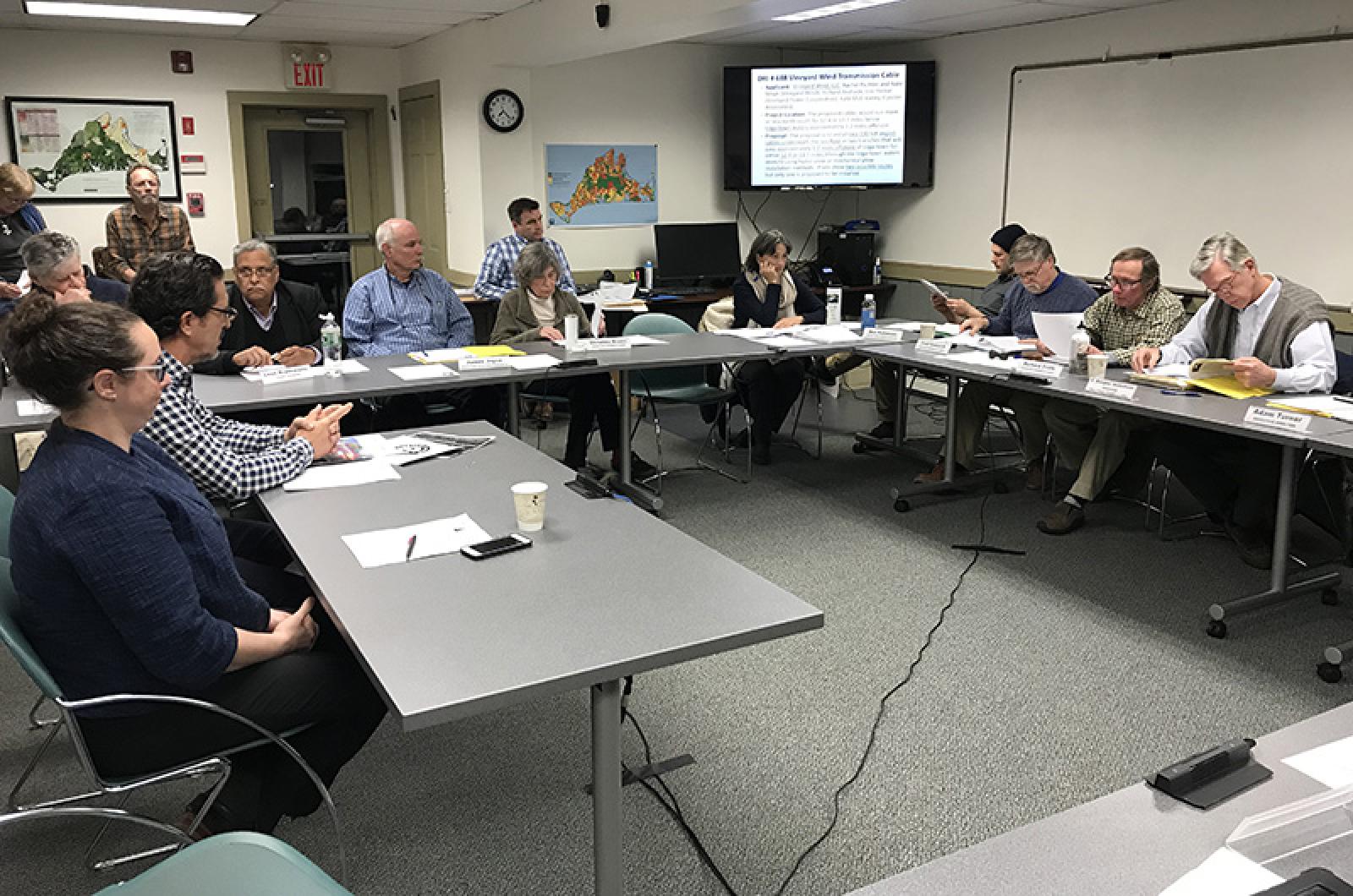Developers who want to build the nation’s first large-scale wind farm in ocean waters south of Martha’s Vineyard saw strong support and also some criticism at a public hearing before the Martha’s Vineyard Commission Thursday night.
Vineyard Wind plans to build 84 turbines 14 miles south of the Vineyard that would produce 800 megawatts of energy.
Most of the project is planned for federal waters. But the commission has jurisdiction over approximately 13 miles of proposed under sea cables that would pass through Edgartown waters just off the eastern shore of Chappaquiddick.
The commission is reviewing that part of the project as a development of regional impact (DRI).
Totaling some 43 to 50 miles in length depending on the route used, the cables will run from the wind farm to a switching station in Barnstable. Developers hope to obtain permits for two different routes through Muskeget Channel because of the potentially rocky sea floor.

At the outset Thursday, development of regional impact coordinator Paul Foley said the main concerns with the cables are environmental impacts on the benthic layer of the sea floor, and proximity to the North Atlantic right whale habitat in Massachusetts waters.
“It’s a bold project,” Mr. Foley said.
In their presentation, spokesmen for Vineyard Wind emphasized their commitment to the Vineyard community through their partnership with Vineyard Power, an Island-based energy cooperative founded in 2009.
“We’ve been at this for about nine years,” said Vineyard Power president Richard Andre. “We are really motivated and concerned about climate change. We as an Island community have a lot to lose, not to mention the impact on mankind,” he said in part.
He also said the project would bring about 40 to 50 wind energy technician jobs to the Vineyard, and that he hoped the majority of them would go to Vineyard residents.
MVC coastal planner Jo-Ann Taylor, who is also the liaison with the Massachusetts Environmental Policy Act, lauded a recent agreement between Vineyard Wind and a group of non-governmental conservation organizations dedicated to preserving the critically endangered right whale. Under the agreement, Vineyard Wind will restrict the speed of its transport vessels to 1o knots and use passive acoustic monitoring to check for the presence of right whales during construction.
“I am gratified to say that the main concern . . .was for the right whale, and the Vineyard Wind agreement addressed those concerns,” she said.
Dan Seidman, a member of the Tisbury planning board and also a member of Vineyard Power, echoed the praise for the right whale agreement.
“I thought that was very proactive,” he said. “This is a proven technology. We’re not trying anything experimental. To me, for lack of a better term, it’s kind of a no-brainer.”
But there were critics too.
Commissioner Clarence A. (Trip) Barnes 3rd expressed skepticism about the viability of finding employees on the Island and housing them. He also questioned developers about potential fallout from a cable malfunction.
“If it breaks underwater, what happens?” Mr. Barnes asked. “Is it like a toaster in a bathtub?”
Rachel Pachter, who’s in charge of permitting for Vineyard Wind, said because the cables will be buried beneath the sea floor, there is no risk for underwater electrification. She also said the entire wind system, including the cable, would immediately shut down if it broke.
The meeting took a turn when another critic stood to speak.
Chilmark resident Helen Parker, who is a psychologist, read a prepared statement about the negative impacts of what is termed infrasound, low-frequency sound that can emanate from wind turbines.
“I’ve worked for social justice for big wind victims with colleagues from south Australia to Denmark,” Mrs. Parker said. “Infrasound is real. It’s impact has been known and documented, and then hidden, for over 30 years.”
But commissioner Richard Toole, who chaired the hearing, called the testimony out of order.
“No, no, no,” Mr. Toole said. “We have no jurisdiction over the wind farm. You’re not talking about the cable. I’ve heard you talk about the noise from the turbines . . . This is inappropriate.”
A heated exchange followed, and Mr. Toole abruptly closed the public hearing, continuing it to an unspecified later date.
Commission chairman Doug Sederholm stepped in with a more moderate tone, asking Ms. Parker to submit her testimony in writing to the commission, which would then make it publicly available online.
“I want to preserve what you have so it is available for the public,” Mr. Sederholm said.
The date for the continued public hearing remained unclear.
In other business, a public hearing on a major expansion project planned by Martha’s Vineyard Community Services was continued to March 7 after the applicant was asked to address additional safety concerns for the entrance road.
Finally, the commission voted to go into executive session to discuss possible litigation with the Wampanoag Tribe of Gay Head (Aquinnah) over the proposed bingo hall.
Aquinnah selectmen have asked the MVC to review the bingo hall as a development of regional impact.







Comments (15)
Comments
Comment policy »